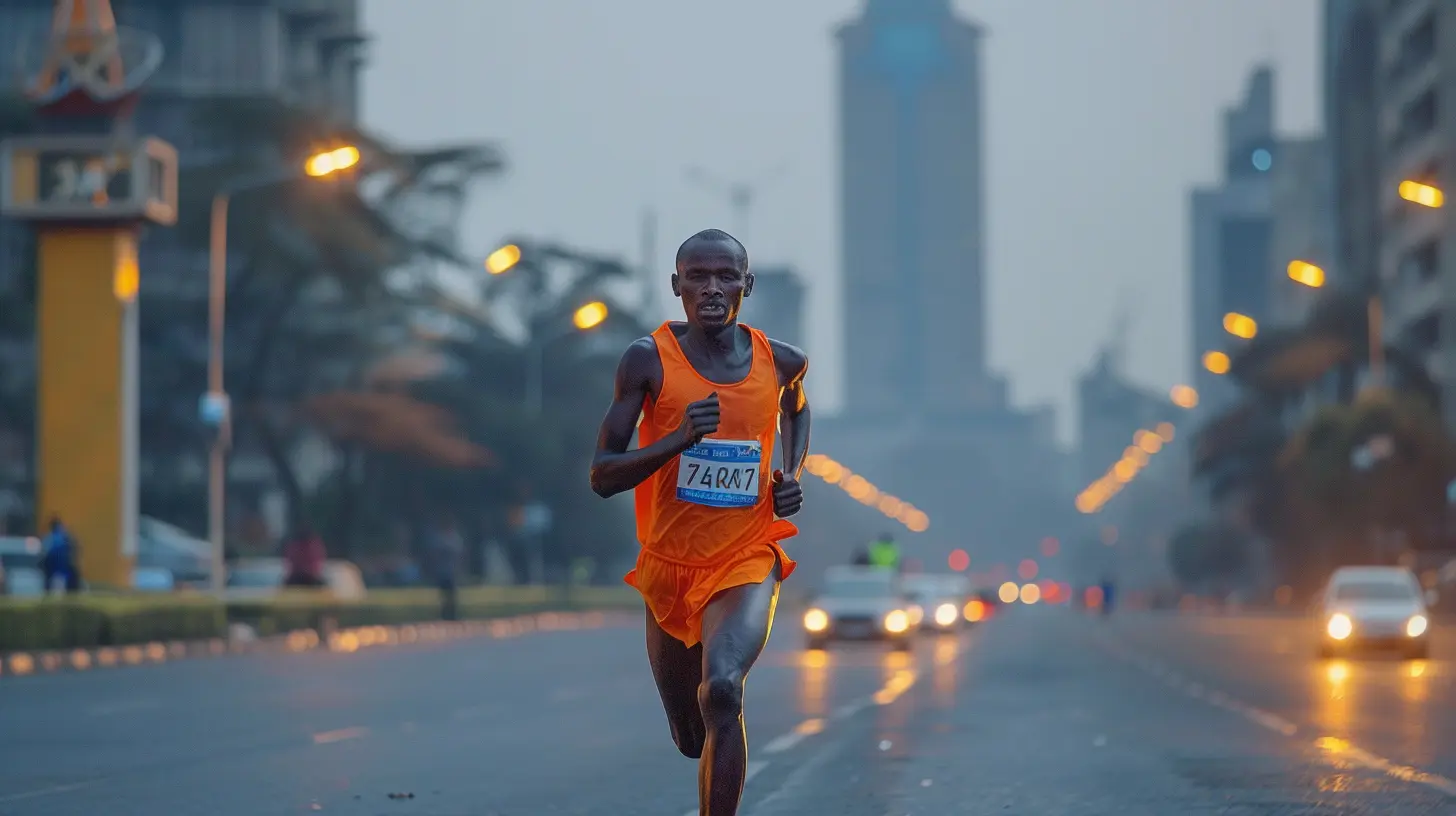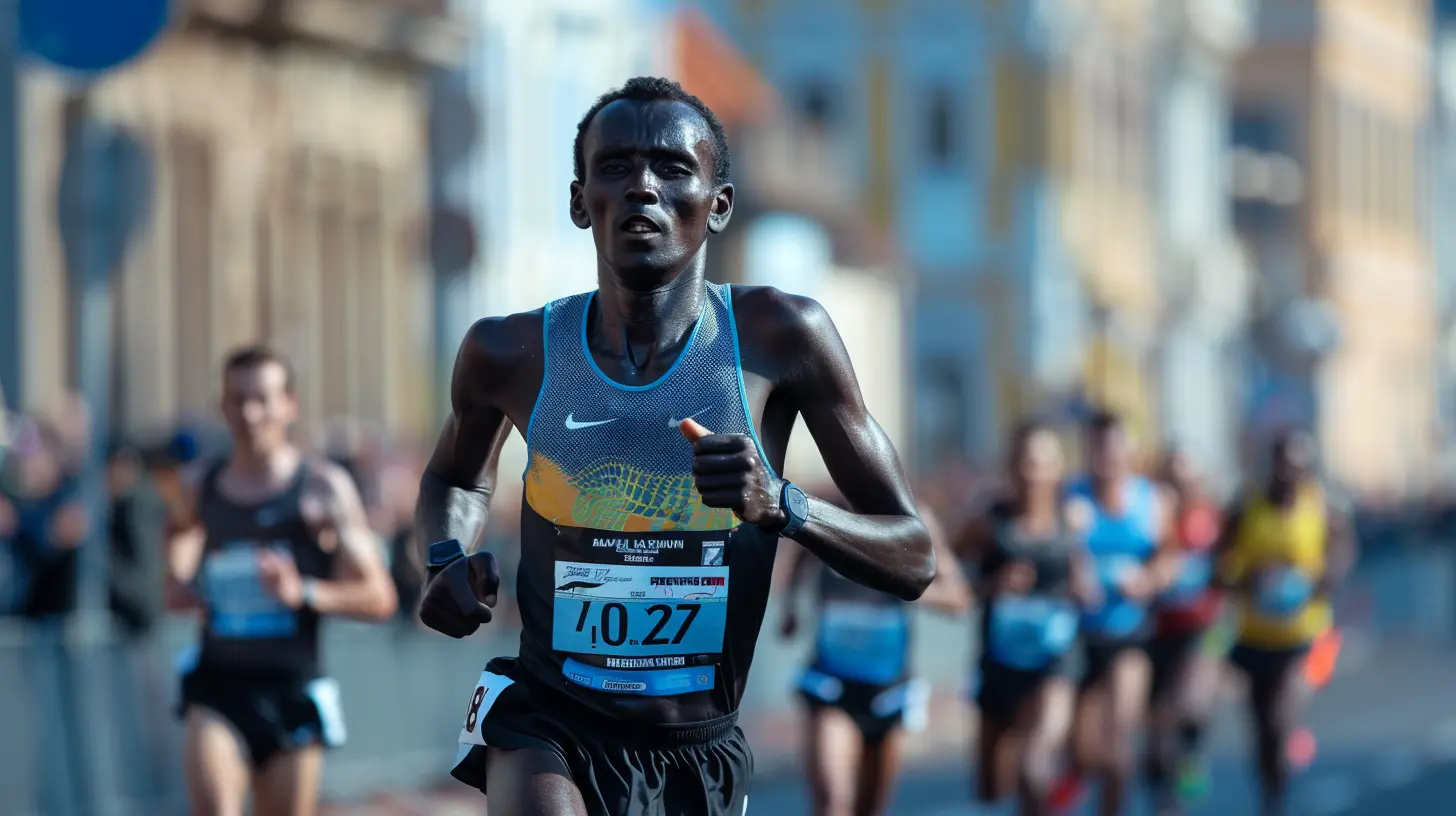Tips for Running a Marathon in a Foreign Country
23 November 2024
Running a marathon is tough. It’s a test of your endurance, mental strength, and willpower. Now imagine running a marathon in a foreign country. Sounds like an adventure, right? But it’s more than just lacing up your shoes and hitting the road. There are a ton of things you need to think about — from language barriers to different weather conditions to cultural differences. Don’t worry, though. I’ve got your back! If you’re planning on running a marathon abroad, here are some tips to help you crush it.

1. Research the Course
One of the first things you should do when planning to run a marathon in a foreign country is research the course. Every marathon is unique, and this is especially true when you’re running in a different country. Whether it’s the elevation, terrain, or even the type of crowd support you’ll get, knowing the course can make all the difference.Are there hills? Is the course flat? Will you be running through a city or along a rural trail? These are all things to consider. Some countries may have marathons that run through historic landmarks or along scenic routes that you wouldn’t want to miss.
Also, check for aid stations and restroom stops along the way. Different countries have different ways of organizing marathons, so don’t assume it’ll be the same as your home country. You don’t want any surprises on race day!

2. Consider the Climate
Running a marathon at home is one thing, but running one in a completely different climate? That’s a whole new ball game. Different countries can come with drastically different weather conditions, and those can heavily impact your performance.For instance, if you’re used to running in cool temperatures and suddenly find yourself in a tropical climate, your body may not be prepared for the heat and humidity. On the flip side, if you’re used to warm conditions and end up running in a country with cold, windy weather, you’ll need to adjust your gear and hydration strategy.
Look up what the weather is typically like during the time of the marathon. And don’t just check the average temperature. Look at the humidity, wind speeds, and even sunrise and sunset times. This will help you plan your race day outfit and hydration strategy.

3. Plan Your Travel and Accommodations
This might seem like a no-brainer, but it’s worth mentioning: plan your travel well in advance! You don’t want to be scrambling to find a flight or hotel at the last minute, especially when you’ve trained so hard for months to get to race day.When booking your accommodation, try to stay close to the starting line if possible. This will save you time and stress on race morning. You don’t want to be stuck in traffic or dealing with public transportation delays when you’re already anxious about the race.
And, don’t just think about getting there. Think about getting there with enough time to adjust. If you’re flying across time zones, give yourself at least a few days to get used to the time difference. Jet lag can seriously mess with your performance, and you need to feel fully rested for race day.

4. Pack Smart
Packing for a marathon abroad isn’t the same as packing for a regular vacation. You’ll need to bring everything you might need for the race, especially if you're unsure what will be available in that country.Start with the essentials: your race gear. Don’t forget your running shoes, race outfit, and any accessories like a hat, sunglasses, or a hydration belt. It’s a good idea to pack in layers, too, since you never know how the weather might change.
Also, pack your nutrition. Different countries may not have the same energy gels or snacks you’re used to. It’s better to bring your own fuel, so you don’t risk messing with your usual routine.
Finally, don’t forget your race bib, if it’s mailed to you in advance, or any paperwork you need to pick it up. And pack your passport, of course. You won’t be going anywhere without that!
5. Adjust to the Local Cuisine
Food can be a big factor when traveling, and it’s even more important when you’re running a marathon. Different countries have different cuisines, and while it’s tempting to dive right into the local dishes, you need to be cautious about what you eat leading up to the race.A pre-race meal is crucial, and you don’t want to risk an upset stomach by eating something your digestive system isn’t used to. Stick to foods you know your body can handle in the days leading up to the marathon, and save the adventurous eating for after the race.
That being said, it’s also important to know what’s available in the country you're visiting. Will you be able to find your usual carb-loading meals like pasta or rice? If not, you might need to bring some snacks or familiar foods with you.
6. Learn Some Key Phrases
If you’re running a marathon in a country where the primary language is different from your own, it helps to learn a few key phrases. You don’t need to become fluent, but knowing basic terms like “water,” “bathroom,” or “help” could go a long way.In some cases, volunteers or other runners may not speak English, and knowing how to communicate in the local language can make the experience smoother. Plus, locals will appreciate your effort to speak their language, even if it’s just a few words.
7. Pay Attention to Time Zones
Running a marathon in a foreign country often means dealing with time zones. If you’re traveling several hours ahead or behind your normal time, your body might feel out of whack. It can affect your sleep, appetite, and overall energy levels.To combat this, try adjusting your sleep schedule a few days before you leave. Gradually shift your bedtime and wake-up time to match the time zone of your destination. This can help ease the transition when you arrive.
Also, once you’re there, try to get on the local schedule as quickly as possible. Eat meals at the local times, and avoid napping too much during the day if you're feeling jet-lagged. You want your body to be in sync with the local time by race day.
8. Train with the Local Terrain in Mind
If you’re used to running on flat roads and you’re heading to a country known for its hilly terrain, you need to adjust your training. Similarly, if you typically run in mild weather and you're going somewhere hot and humid, you need to prepare your body for the shift.Incorporate training runs that mimic the environment you’ll be racing in. If you're expecting hills, hit the trails or roads with inclines. If you're expecting heat, try running in the middle of the day (safely) or even in a sauna-like environment.
The more you can simulate the conditions of the marathon before race day, the better prepared you’ll be.
9. Understand the Local Culture
Every country has its own culture, and marathons can be a reflection of that. In some places, marathons are a huge deal, with spectators lining the streets and cheering for every runner. In other places, it might be a quieter, more low-key event.Understanding the local culture will help you know what to expect during the race. Some countries might have different customs or traditions related to races, and it’s always a good idea to be aware of these.
For example, in some countries, it’s normal for spectators to offer food or drinks to runners. In others, it might be frowned upon to take anything from someone who isn’t an official race volunteer.
10. Have Fun and Soak in the Experience
At the end of the day, running a marathon in a foreign country isn’t just about the race — it’s about the experience. You’re in a new place, surrounded by new people, and you’re doing something incredible. Don’t forget to enjoy the journey!Take in the sights and sounds of the city or countryside you’re running through. High-five a local kid on the sidelines. Smile at fellow runners from around the world. Sure, you’re there to push your limits, but it’s also a chance to connect with a global community of runners.
Soak in every moment, and when you cross that finish line, you’ll not only have completed a marathon, but you’ll have created memories that will last a lifetime.
Conclusion
Running a marathon in a foreign country can be an unforgettable experience. It’s a chance to challenge yourself physically and immerse yourself in a new culture. But to make the most of it, you need to be prepared. From researching the course to adjusting to the climate and packing smart, every detail counts. So, take these tips to heart, plan ahead, and get ready for the adventure of a lifetime!all images in this post were generated using AI tools
Category:
MarathonAuthor:

Uziel Franco
Discussion
rate this article
18 comments
Zeke Good
Running a marathon in a foreign country is a thrilling adventure! Embrace the new sights, cultures, and experiences along the way. Remember to stay hydrated, listen to your body, and enjoy every moment. Each step is not just a challenge, but a celebration of your journey! You're capable of greatness!
April 7, 2025 at 4:52 AM

Uziel Franco
Thank you for your inspiring words! Embracing the journey and staying mindful is key to a memorable marathon experience. Happy running!
Susan McKittrick
Great tips! Embracing the local culture can enhance your marathon experience, making it memorable beyond just the race itself.
February 10, 2025 at 1:18 PM

Uziel Franco
Thank you! Embracing local culture truly enriches the marathon experience and creates lasting memories. Happy running!
Kenneth McMeekin
When running a marathon abroad, embrace the local culture: try traditional foods for energy, familiarize yourself with the course terrain, and connect with fellow runners. These experiences enrich your journey and enhance your race day performance.
February 2, 2025 at 1:37 PM

Uziel Franco
Absolutely! Embracing local culture not only fuels your body with traditional foods but also creates a memorable experience. Connecting with fellow runners enhances camaraderie and may even improve your race performance!
Ronan Bass
Running a marathon abroad transcends physical endurance; it’s a journey into cultural landscapes, forging connections and embracing the shared human spirit through sport.
January 27, 2025 at 1:09 PM

Uziel Franco
Absolutely! Running a marathon abroad is not just about the miles; it’s a unique opportunity to immerse yourself in a new culture and connect with fellow runners. Embrace the experience!
Emery Morgan
Pro tip: Forget running—just aim for the best post-race snacks abroad!
January 22, 2025 at 8:50 PM

Uziel Franco
Great tip! Enjoying local snacks can be a delicious reward after all that hard work!
Fletcher Harris
Embrace the journey; every mile tells a story!
January 15, 2025 at 12:49 PM

Uziel Franco
Absolutely! Each step offers a unique experience and memory. Enjoy every moment of the adventure!
Caitlin McHugh
Embrace the journey; every mile tells a story.
January 12, 2025 at 1:01 PM

Uziel Franco
Absolutely! Each mile is a unique adventure that adds to the experience of running abroad. Enjoy every step!
Sylvan Kelly
Great tips! Embracing local culture while preparing for a marathon abroad enhances the experience. Remember to acclimate, explore the course, and savor post-race celebrations!
December 30, 2024 at 11:49 AM

Uziel Franco
Thank you! Embracing the local culture truly enriches the marathon experience. Happy running and exploring!
Hadley McCallum
Embracing the unfamiliar can transform a marathon into a journey of self-discovery. Each step through foreign streets not only challenges our bodies but also deepens our connection to diverse cultures, enriching the experience far beyond the finish line.
December 27, 2024 at 4:56 AM

Uziel Franco
Absolutely! Embracing the unfamiliar truly enhances the marathon experience, turning it into a profound journey of self-discovery and cultural connection.
Kara Gomez
Running a marathon abroad is an exhilarating challenge! Embrace the local culture, stay hydrated, and trust your training. Conquer those miles with confidence and enjoy the experience!
December 21, 2024 at 12:22 PM

Uziel Franco
Thank you! Embracing the local culture and staying hydrated are key. Wishing all runners an incredible experience!
Courtney McIlroy
Running a marathon in a foreign land is more than just miles; it’s a journey into the unknown. The thrill of new terrain, unfamiliar sounds, and local traditions can transform your race experience. But beware—the midnight whispers of the city may reveal secrets only the brave dare to uncover.
December 17, 2024 at 3:36 AM

Uziel Franco
Absolutely! Embracing the local culture and surroundings can elevate your marathon experience, but always stay aware and prepared for the unexpected. Happy running!
Etta McKenzie
Running a marathon abroad? Don't just pack your sneakers—pack a sense of adventure! Embrace the culture, fuel wisely, and remember: even GPS can get lost in translation!
December 2, 2024 at 12:33 PM

Uziel Franco
Absolutely! Embracing the local culture and being adaptable can enhance your marathon experience significantly. Happy running!
Zephyrian Sanchez
Embrace the miles beneath foreign skies, With every step, let adventure rise. Strength and spirit, your heart’s guide.
November 29, 2024 at 8:51 PM

Uziel Franco
Thank you! Embracing the journey truly enhances the marathon experience. Happy running!
Jinx McGrady
Great tips! Preparing for a marathon abroad can be daunting, but these insights on cultural awareness, local resources, and logistics are invaluable. Embracing the experience can make all the difference in your race day.
November 28, 2024 at 1:51 PM

Uziel Franco
Thank you! I'm glad you found the tips helpful. Embracing the local culture truly enhances the marathon experience!
Vanya Matthews
Stride through cultures, conquer distances.
November 27, 2024 at 5:33 AM

Uziel Franco
Embrace the journey! Every step connects you to new experiences and cultures.
Fenris Martinez
Great tips! Preparing for a marathon abroad can be challenging, but your advice on local customs, hydration, and route familiarity really stands out. It'll definitely help runners stay focused and enjoy the experience. Thanks for sharing!
November 25, 2024 at 3:53 AM

Uziel Franco
Thank you! I'm glad you found the tips helpful. Enjoy your marathon adventure!
Samuel Beck
Embrace the adventure—memories will last forever!
November 24, 2024 at 5:31 AM

Uziel Franco
Absolutely! Embracing the adventure makes the experience unforgettable. Happy running!
Reece McGrady
When preparing for a marathon abroad, prioritize research on local customs, climate, and health regulations. Ensure your travel documents are in order, and consider acclimating to the environment ahead of time. Staying hydrated and familiarizing yourself with the course will enhance your overall experience and performance.
November 23, 2024 at 3:45 AM

Uziel Franco
Great tips! Researching local customs and acclimating to the climate are essential for a successful marathon experience abroad.
MORE POSTS

The Essential Guide to Hydration for Endurance Athletes

Top Recovery Strategies for Endurance Athletes
![The Power and Precision of [Player Name]: A Breakdown of Their Game](/pictures/blog/small/the-power-and-precision-of-player-name-a-breakdown-of-their-game_2.webp)
The Power and Precision of [Player Name]: A Breakdown of Their Game

The Pinnacle of Excellence: Hall of Fame Stories You Should Know

Unpacking the Laws of Rugby: Understanding Key Rules for a Better Game

The Significance of All-Star Games for Player Legacies

How the All-Star Game Changed the Way We View Athlete Endurance

How to Find the Right Marathon for Your Skill Level

The Rise of Women in Skateboarding: Changing the Game

The Ultimate Marathon Training Plan for Busy Athletes

The Evolution of Basketball Shoes: From Court to Street